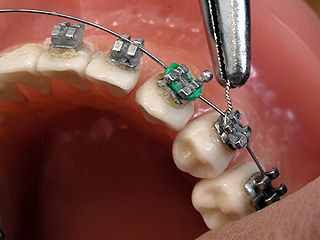
Orthodontics is a dentistry specialty that addresses the diagnosis, prevention, management, and correction of mal-positioned teeth and jaws, as well as misaligned bite patterns. It may also address the modification of facial growth, known as dentofacial orthopedics.

Orthodontic retainers are custom-made devices, usually made of wires or clear plastic, that hold teeth in position after surgery or any method of realigning teeth. Once a phase of orthodontic treatment has been completed to straighten teeth, there remains a lifelong risk of relapse due to a number of factors: recoil of periodontal fibres, pressure from surrounding soft tissues, the occlusion and patient’s continued growth and development. By using retainers to hold the teeth in their new position for a length of time, the surrounding periodontal fibres adapt to changes in the bone which can help minimize any changes to the final tooth position after the completion of orthodontic treatment. Retainers may also be used to treat overjets.

Dental braces are devices used in orthodontics that align and straighten teeth and help position them with regard to a person's bite, while also aiming to improve dental health. They are often used to correct underbites, as well as malocclusions, overbites, open bites, gaps, deep bites, cross bites, crooked teeth, and various other flaws of the teeth and jaw. Braces can be either cosmetic or structural. Dental braces are often used in conjunction with other orthodontic appliances to help widen the palate or jaws and to otherwise assist in shaping the teeth and jaws.

Clear aligners are orthodontic devices that are a transparent, plastic form of dental braces used to adjust teeth.

In orthodontics, a malocclusion is a misalignment or incorrect relation between the teeth of the upper and lower dental arches when they approach each other as the jaws close. The English-language term dates from 1864; Edward Angle (1855–1930), the "father of modern orthodontics", popularised it. The word "malocclusion" derives from occlusion, and refers to the manner in which opposing teeth meet.
Orthodontic technology is a specialty of dental technology that is concerned with the design and fabrication of dental appliances for the treatment of malocclusions, which may be a result of tooth irregularity, disproportionate jaw relationships, or both.
Straumann Group is a Swiss company based in Basel (Switzerland) manufacturing dental implants and specialized in related technologies. The group researches, develops, manufactures and supplies dental implants, instruments, biomaterials, CADCAM prosthetics, digital equipment, software, and clear aligners for applications in replacement, restorative, orthodontic and preventative dentistry.

SureSmile is a type of customized orthodontic arch wires used by orthodontists to straighten teeth. The technique utilizes 3-D imaging, treatment planning software and a robot to create the wires. The technique is reported to decrease the time required to complete orthodontic treatment by 34% and increase the precision of the results.

All Smiles Dental Centers (ADSC) was an American chain of dental clinics, with its headquarters in Farmers Branch, Texas in the Dallas-Fort Worth area, The chain operates dental clinics in the Dallas-Fort Worth area and in Greater Houston. The company was the management service organization providing business support services to All Smiles Dental Professionals, P.C. The patients mostly consisted of children in low-income Hispanic communities.
Pre-eruption guidance is an orthodontic treatment method that allows for expansion of existing erupting teeth long before they appear in the mouth. The use off pre-eruption guidance appliances and the timing of extractions of certain deciduous teeth aligns the teeth naturally as opposed to orthodontic mechanical movement of permanent teeth into alignment after they have erupted. Research shows that pre-eruption guidance produces far more stable tooth alignment than alternative treatments.
Digital dentistry refers to the use of dental technologies or devices that incorporates digital or computer-controlled components to carry out dental procedures rather than using mechanical or electrical tools. The use of digital dentistry can make carrying out dental procedures more efficient than using mechanical tools, both for restorative as diagnostic purposes. Used as a way to facilitate dental treatments and propose new ways to meet rising patient demands.
Lingual braces are one of the many types of the fixed orthodontic treatment appliances available to patients needing orthodontics. They involve attaching the orthodontic brackets on the inner sides of the teeth. The main advantage of lingual braces is their near invisibility compared to the standard braces, which are attached on the buccal (cheek) sides of the tooth. Lingual braces were invented by Craven Kurz in 1976.
Harold Dean Kesling was an American orthodontist who is known for developing the tooth positioning appliance called "Positioner". This appliance is used in orthodontics at the end of treatment to allow teeth to settle in occlusion.
Craven Kurz was an American orthodontist who is known to be the inventor of the lingual braces in 1975. He was also the founding president of the American Lingual Orthodontic Association.
Dustin Burleson is an American orthodontist and consultant.

SmileDirectClub was a teledentistry company. The company was co-founded in 2014 by Jordan Katzman and Alex Fenkell. It was based in Nashville, Tennessee, United States. SmileDirectClub shut down in December 2023, less than three months after filing for Chapter 11 bankruptcy.
Muhammad Ziaullah Khan Chishti is a Pakistani-American investor and business executive. He is the founder of Afiniti and TRG Global.
John Mew is a British orthodontist. He is the founder of orthotropics and mewing. Orthotropics is a form of oral posture training that claims to guide facial growth and is not supported by mainstream orthodontists. John Mew's son Michael Mew is also an orthodontist and has also practised and promoted the idea of orthotropics.

DrSmile is a dentistry brand by German startup Urban Technology GmbH based in Berlin.
Georgia School of Orthodontics (GSO) is an orthodontic school located in Atlanta, Georgia, United States. It was established in 2016 and offers a 36 month Advanced Specialty Education Program in Orthodontics & Dentofacial Orthopedics. In response to GSO's growth, the school opened another location in Georgia in 2017.








